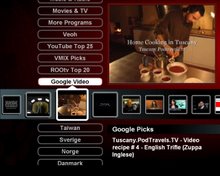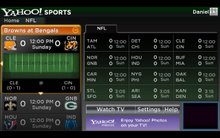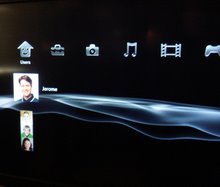Solutions: With no broadly accepted solution to TV digital convergence, the Cable TV service providers are looking to expand their systems to satisfy their users’ demand for new digital services. They bring with them the business models of the US Cable TV industry.
Behind the scene: Active-TV technology combines the best of the TV industry (longevity, reliability, openness) with the best of the PC industry (computationally power, web 2.0 software technology, openness). By enabling the use of web 2.0 methods, active-TV technology is ideal for low-cost TV developers who wish to improve upon or circumvent US Cable TV business models.
Many analysts and developers anticipate mainstream TV users will have their TVs connected to the internet via residential broadband service, thereby enabling browsing of internet-delivered video or web pages formatted for the TV (i.e. TV-web). The success of the internet, added to US consumer familiarity with paying monthly fees for cable TV service, has contributed to speculation about what new revenue-generating services can be enabled by networked TVs.
An ABI Research report, “Pay-TV and the American Consumer” examines what new service may be offered (see "chart 1.6" below):

There seems much more desire to do a better job at “monetizing” (as the MBA’s say) the application of internet technology at the TV than was apparent when the PC first connected to the internet. For example: currently TV suppliers do not share in the revenue produced by video or ads consumed at the TV, they make their money from the retail purchase of the TV. Similarly, laptop computer suppliers don’t make any money from the owners’ viewing of advertising on webpages accessed by the laptop. However, there are some TV developers and US pay-TV suppliers, exploring how they can “share” in the video and ad revenue produced by an internet-connected TV.
PC and laptop users are already familiar with unrestricted PC-web browsing. However, to enforce these new monetizing strategies, it is usually suggested that the TV function with a portal service rather than have freedom to browse the internet. Video aggregators play a key role in the proposed portal strategy. These aggregators provide the video for the portal. If a networked TV is ‘locked’ to a portal then the TV supplier is in a good position to negotiate revenue sharing terms with the aggregator. The aggregator supplies the TV UI and hence via pre-run, or other display methods, is ideally able to also inject advertising.
Unproven is the TV buyer’s willingness to purchase a TV tied to portal service. Traditionally, a Set-Top Box (STB) could be tied to a particular service, but not a TV, which was expected to “tune” to any channel. Perhaps this is why Apple has not introduced an integrated Apple TV, assuming that like the current Apple TV box, the TV would be restricted in the internet URLs it could ‘tune-in’. Likely only Apple’s TV portal would be accessible (TV-web pages have a URL network address just like PC-web pages).
Turning to the ABI Research report: “Perhaps the truism that Chart 1.6 supports the most is that pay-TV providers have only a tenuous hold on the vast majority of their subscribers, and they are vulnerable to churn. Several respondents voiced their frustration with their service providers’ pricing. The following comments reflect customer discontent:
‘I feel that cable prices have become outrages.’ ” [ABI Research report]
The ABI analysts asked US TV users if they would pay for new features such as accessing email, communication features, interactive services, transferring content from a PC, viewing personal content, and much more. For example the report states, “an additional $20 might bring communications features such as instant messaging and the ability to read e-mail on the screen.” I think they mean for an additional $20 per month. I am surprised at their willingness to pay for TV features which are generally regarded as free when accessed from a PC or notebook computer. Possibly unknown to some of the survey responders is that today the purchase of an active-TV technology enabled box, such as the D-Link DSM-520, will bring many of these features and without the monthly fee. This is because the TV user is provided with unlocked web 2.0 technology.
All of the ABI suggested features can be enabled with widgets, Flash, HTML, AJAX and other familiar Web 2.0 methods; such as TV widgets which support social network communication at the TV. Given that TV developers are currently integrating active-TV technology which will shortly be available at retail, unless they all enable URL filtering, portal locking or some legal device, the TV purchaser will be able to choose a freer form of internet-video browsing and new TV feature selection. If my analysis is correct, the business models applied to the networked TV will be similar to those applied to the networked notebook computer rather than the US cable TV service.
The ABI report would be even more interesting if they had included in their survey questions about selecting new TV features via the monthly service fee STB-approach, versus the choose-your-own website laptop-approach. Some in the TV/STB industry suggest the TV user may prefer the familiarity and quality of the single TV UI provided by the closed portal service. They suggest the TV user will become confused and dissatisfied with the varying nature of websites. By that they mean PC-websites or TV-websites do not have to conform to any standards, anyone can build them and web 2.0 methods can be applied as desired by their developer and not the TV supplier. I look forward to what is produced by this chaos. I think the TV user will ultimately appreciate and benefit from this openness.
Feedback, corrections and comments welcome. Contact me for more information or support with active-TV technology development.
Daniel Mann









1 comment:
Thanks for share your information. Your blog has been really great. I learned a lot from here. I hope you will give us such more awesome blogs. Thank you. Server stability largely determines the kind of viewership you get to enjoy considering that the television content is broadcast through servers. Choose Best IPTV subscription provider whose servers are stable enough to save you from freezing and stuttering when you are streaming and here you will get best IPTV Povider, IPTV Subscription, smart iptv, best iptv, best IPTV Services etc
Post a Comment